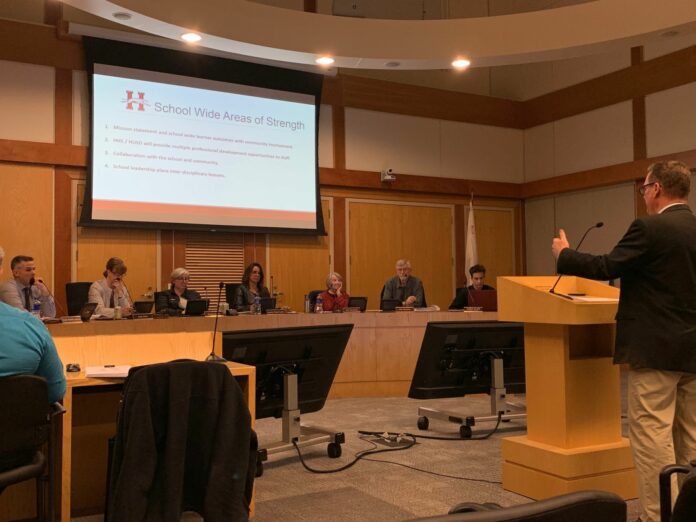
District receives $57,305 for low performing students block grant
Healdsburg High School administrators have more to be proud of after news broke that the school received top Western Association of Schools and Colleges (WASC) accreditation.
The announcement was made three weeks after the site completed a two-year review and analysis, and while the WASC report cites several areas of strength, it also points to areas where the school can improve, such as closing performance gaps for English language learners.
HHS principal Bill Halliday spoke of the WASC report at the Feb. 20 school board meeting and said of the accreditation, “If they were giving out prizes, then this would be the top prize the accreditation could give us, so great work.”
According to Halliday, the WASC accreditation process starts when high school staff are split into focus groups where they discuss how they can improve points of weakness identified from previous WASC reviews. School staff then creates a report detailing what they’ve accomplished and what they still need to work on.
WASC representatives then make multiple trips to the school site and review their progress by conducting a series of staff, student and teacher interviews. WASC then formulates their review and report based on their fieldwork.
“What they really look for when they come and visit and read our report is, what they identified in the prior report and what we addressed. There are critical areas (of improvement) and they look at what we’ve done as a high school to address those critical points,” Halliday explained.
He added that one of the reasons the school received a good report was its action toward working on critical areas of improvement cited in the previous WASC report.
“We showed striking improvement,” Halliday said.
The WASC review cited several areas of strength: a rigorous academic program with various course options, a clear and concise mission statement and student learning outcomes (SLO), opportunities for teachers to collaborate and develop their work, multiple method for tracking student benchmarks and progress and a positive school environment.
“We went forward and changed our mission statement and talked with students to make sure it fit,” Halliday said.
The HHS mission statement states, “The mission of Healdsburg High School is to create a supportive community of diverse learners that produce independent, collaborative and innovative work, and reflects the skills and challenges of the 21st century.”
In regards to professional development, time for teachers to work and collaborate, the report stated that the school provides good opportunity for teachers to develop lessons, tests and other work.
“We have good collaboration with the school community and … teachers and school leadership. We are proud of our creativity and our flexibility,” Halliday said.
For garnering student progress, the school has several benchmark tests such as the California Assessment of Student performance and Progress (CAASPP) and the English Language Arts common core standards test (ELA). While this was a plus the report added that more progress tracking methods would be beneficial to the school.
The school’s environment was also a plus.
“By and large we have a very welcoming environment and students and teachers feel very well respected,” Halliday added.
Even though there were several areas of strength, the report also recognized areas where the school could improve. These include closing the performance gap between English language learners and native English speakers, expanding post-secondary opportunities such as college classes, continuing to encourage parental involvement of all socio-economic progress and to continue growth of programs at a sustainable rate by not offering too many choices for a decreasing student population.
According to the report, Anglo students continue to outperform Hispanic/Latino students meriting the need for an increased focus on supporting Latino students as well as socioeconomic disadvantaged and special-education students.
Halliday said the school will “continue to crunch data” and work on math as well a close gap between English language learners and native English speakers.
Low performing students grant
During Wednesday’s meeting the school board also unanimously voted to approve the spending plan for the $57,305 low performing students block grant.
The grant amounts to a total of $71,137 with the HUSD receiving $57,305 and the Healdsburg Charter School receiving $13,832 of that figure.
This is a one-time grant from the California Department of Education (CDE) allocated for low performing students during the 2018-19 fiscal year to eligible local educational agencies and charter schools.
Students who are considered as low performing are those who score a 1 or 2 on either or both the CAASPP math and ELA assessments and who are not English language learners, low-income or special education students.
Upon receiving the funds, the school is required to create a plan discussing how the funds will increase or improve services for the students who need an increase in academic achievement.
In this case the fund-spending plan will benefit 36 qualifying students as well as the district as a whole with district-wide math help programs.
Funds will be used for several programs to provide these students with extra help.
According to HUSD Superintendent Chris Vanden Heuvel, two teachers will lead an all grades math lab at least two days a week. The lab will focus on problem solving and visualization at an estimated cost of $30,800.
“It is not just homework help, they really are taking on more of a growth mindset looking at math in a different way that is more creative and challenges them to solve problems and to endure the pitfalls of failing and persevere,” Vanden Heuvel said.
There will also be at least one week of collaborative planning and learning for teachers in the summers of 2019 and 2020 with nine teachers from the Fitch Mountain campus, HES, three from the junior high and five from the high school. Estimated costs for the intensive planning session are set at $27,300. Lastly, a mathematics coach will be provided for grades six to eight.
Before the “yes” vote for the spending plan Trustee Mike Potmesil said it would be nice to track student progress with the help programs and come back with a report on their headway.








